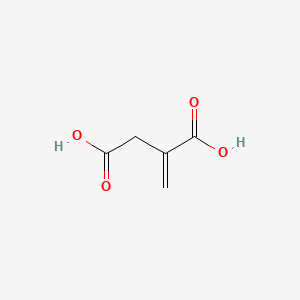Ferroptosis-centered Drug Response Information
General Information of the Drug (ID: ferrodrug0137)
| Name |
Itaconic acid
|
||||
|---|---|---|---|---|---|
| Synonyms |
Itaconic acid; 97-65-4; 2-Methylenesuccinic acid; METHYLENESUCCINIC ACID; 2-methylidenebutanedioic acid; Methylenebutanedioic acid; Propylenedicarboxylic acid; Butanedioic acid, methylene-; itaconate; 2-Propene-1,2-dicarboxylic acid; Succinic acid, methylene-; 2-methylenebutanedioic acid; MFCD00004260; 25119-64-6; AI3-16901; 2-Methylene-Succinic Acid; CHEMBL359159; butanedioic acid, 2-methylene-; DTXSID2026608; CHEBI:30838; NSC3357; NSC-3357; Q4516562YH; DTXCID006608; CAS-97-65-4; HSDB 5308; methylene-butanedioicaci; NSC 3357; EINECS 202-599-6; Methylenesuccinate; UNII-Q4516562YH; ITN; Methylenebutanedioate; 2-Methylenesuccinate; Propylenedicarboxylate; 2-methylenebutanedioate; Itaconic acid, >=99%; bmse000137; Probes1_000076; Probes2_000247; EC 202-599-6; 2-Methylenesuccinic acid #; ITACONIC ACID [MI]; NCIStruc1_001783; NCIStruc2_000502; 2-methylene-butanedioic acid; NCIOpen2_004822; SCHEMBL21523; ITACONIC ACID [INCI]; 2-Propene-1,2-dicarboxylate; Itaconic acid, analytical standard; Succinic acid, methylene- (8CI); HY-Y0520; Tox21_201299; Tox21_303071; BBL011584; BDBM50036216; LMFA01170063; s3095; STL163322; AKOS000118895; 2-Hydroxy-3-Naphthoyl-2-Naphthylamine; SB67306; Butanedioic acid,ethylidene-,(E)-(9ci); NCGC00249019-01; NCGC00257141-01; NCGC00258851-01; AS-11816; CS-0015302; FT-0627543; M0223; EN300-18045; C00490; E80791; Q903311; Z57127539; F2191-0234; 2-METHYLENE,1,4-BUTANEDIOIC ACID (ITACONIC ACID); 53EEC7A3-4846-4588-BBC9-CB8846377B96; InChI=1/C5H6O4/c1-3(5(8)9)2-4(6)7/h1-2H2,(H,6,7)(H,8,9
Click to Show/Hide
|
||||
| Structure |
 |
||||
| Formula |
C5H6O4
|
||||
| IUPAC Name |
2-methylidenebutanedioic acid
|
||||
| Canonical SMILES |
C=C(CC(=O)O)C(=O)O
|
||||
| InChI |
InChI=1S/C5H6O4/c1-3(5(8)9)2-4(6)7/h1-2H2,(H,6,7)(H,8,9)
|
||||
| InChIKey |
LVHBHZANLOWSRM-UHFFFAOYSA-N
|
||||
| PubChem CID | |||||
Full List of Ferroptosis Target Related to This Drug
Nuclear receptor coactivator 4 (NCOA4)
| In total 1 item(s) under this Target | |||||
| Experiment 1 Reporting the Ferroptosis-centered Drug Act on This Target | [1] | ||||
| Target for Ferroptosis | Driver | ||||
| Responsed Disease | Pancreatic cancer | ICD-11: 2C10 | |||
| Pathway Response | Fatty acid metabolism | hsa01212 | |||
| Ferroptosis | hsa04216 | ||||
| Cell Process | Cell ferroptosis | ||||
| Cell autophagy | |||||
| In Vitro Model | PANC-1 cells | Pancreatic ductal adenocarcinoma | Homo sapiens | CVCL_0480 | |
| THP-1 cells | Childhood acute monocytic leukemia | Homo sapiens | CVCL_0006 | ||
| In Vivo Model |
To generate murine subcutaneous tumors, 5 x 106 PANC1 cells in 100 ul PBS were injected subcutaneously into the right of the dorsal midline in 6- to 8-week-old femaleathymic nude mice(n = 6 mice/group). After the tumor reached 60-80 mm3 on day 7, the mice were randomly grouped and then given intraperitoneal injections with itaconic acid (50 mg/kg, once every other day) at day 7 for 2 weeks.
Click to Show/Hide
|
||||
| Response regulation | Itaconic acid-induced expression and activation of NFE2L2 serves as a defense mechanism to limit ferroptosis by producing antioxidant genes. Consequently, impaired NCOA4 expression prevented, whereas a disrupted NFE2L2 pathway enhanced, sensitivity to itaconic acid-induced ferroptosis in pancreatic cancer cells. | ||||
Nuclear factor erythroid 2-related factor 2 (NFE2L2)
| In total 1 item(s) under this Target | |||||
| Experiment 1 Reporting the Ferroptosis-centered Drug Act on This Target | [1] | ||||
| Target for Ferroptosis | Marker/Suppressor | ||||
| Responsed Disease | Pancreatic cancer | ICD-11: 2C10 | |||
| Pathway Response | Fatty acid metabolism | hsa01212 | |||
| Ferroptosis | hsa04216 | ||||
| Cell Process | Cell ferroptosis | ||||
| Cell autophagy | |||||
| In Vitro Model | PANC-1 cells | Pancreatic ductal adenocarcinoma | Homo sapiens | CVCL_0480 | |
| THP-1 cells | Childhood acute monocytic leukemia | Homo sapiens | CVCL_0006 | ||
| In Vivo Model |
To generate murine subcutaneous tumors, 5 x 106 PANC1 cells in 100 ul PBS were injected subcutaneously into the right of the dorsal midline in 6- to 8-week-old femaleathymic nude mice(n = 6 mice/group). After the tumor reached 60-80 mm3 on day 7, the mice were randomly grouped and then given intraperitoneal injections with itaconic acid (50 mg/kg, once every other day) at day 7 for 2 weeks.
Click to Show/Hide
|
||||
| Response regulation | Itaconic acid-induced expression and activation of NFE2L2 serves as a defense mechanism to limit ferroptosis by producing antioxidant genes. Consequently, impaired NCOA4 expression prevented, whereas a disrupted NFE2L2 pathway enhanced, sensitivity to itaconic acid-induced ferroptosis in pancreatic cancer cells. | ||||
